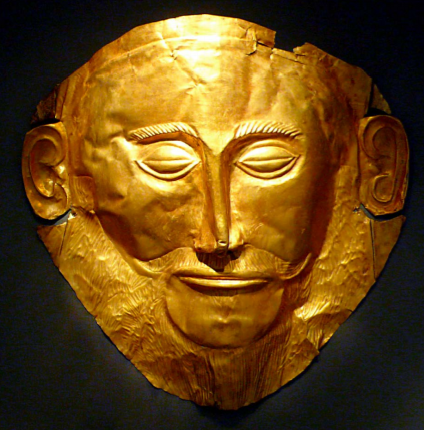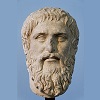5.8: From Mythology to History
- Page ID
- 10808
The terms “mythology” and “history” may seem, by modern definitions, to be antithetical. After all, mythology refers to stories that are clearly false, of long-forgotten gods and heroes and their miraculous feats. History, on the other hand, refers to actual events that involved real people. And yet, the idea that the two are opposites would have seemed baffling to a typical resident of the ancient Mediterranean world. Rather, gods and myths were part of the everyday life, and historical events could become subsumed by myths just as easily as myths could become a part of history. For instance, Gilgamesh, the hero of the Sumerian Epic of Gilgamesh, was a real king of Uruk, yet he also became the hero of the epic. Each Greek city-state, in particular, had a foundation myth describing its origins as well as its own patron gods and goddesses. Etiological myths, furthermore, served to explain why certain institutions or practices existed; for instance, the tragic trilogy Oresteia of the Athenian poet Aeschylus tells the etiological myth for the establishment of the Athenian murder courts in the Classical period.
Yet, while the Greeks saw mythology and history as related concepts and sometimes as two sides of the same coin, one specific mythical event marked, in the eyes of the earliest known Greek historians, the beginning of the story of Greek-speaking peoples. That event was the Trojan War.
Homer and the Trojan War
It is telling that the two earliest Greek historians, Herodotus, writing in the mid-fifth century BCE, and Thucydides, writing in the last third of the fifth century BCE, began their respective histories with the Trojan War, each treating it as a historical event. The Homeric epics Iliad and Odyssey portray the war as an organized attack of a unified Greek army against Troy, a city in Asia Minor (see map 5.5.1). The instigating offense? The Trojan prince Paris kidnapped Helen, the most beautiful woman in the world, from her husband Menelaus, king of Sparta. This offense, interpreted as a slight to Menelaus’ honor, prompted Agamemnon, king of Mycenae and Menelaus’ brother, to raise an army from the entire Greek world and sail to Troy. The mythical tradition had it that after a brutal ten-year siege, the Greeks resorted to a trick: they presented the Trojans with a hollow wooden horse, filled with armed soldiers. The Trojans tragically accepted the gift, ostensibly intended as a dedication to the goddess Athena. That same night, the armed contingent emerged from the horse, and the city finally fell to the Greeks. Picking up the story ten years after the end of the Trojan War, the Odyssey then told the story of Odysseus’s struggles to return home after the war and the changes that reverberated throughout the Greek world after the fall of Troy.
The Homeric epics were the foundation of Greek education in the Archaic and Classical periods and, as such, are a historian’s best source of pan-Hellenic values. A major theme throughout both epics is personal honor, which Homeric heroes value more than the collective cause. For example, when Agamemnon slights Achilles’ honor in the beginning of the Iliad, Achilles, the best hero of the Greeks, withdraws from battle for much of the epic, even though his action causes the Greeks to start losing battles until he rejoins the fight. A related theme is competitive excellence, with kleos (eternal glory) as its goal: all Greek heroes want to be the best; thus, even while fighting in the same army, they see each other as competition. Ultimately, Achilles has to make a choice: he can live a long life and die unknown, or he can die in battle young and have everlasting glory. Achilles’ selection of the second option made him the inspiration for such historical Greek warriors and generals as Alexander the Great, who brought his scroll copy of the Iliad with him on all campaigns. Finally, the presence of the gods in the background of the Trojan War shows the Greeks’ belief that the gods were everywhere, and acted in the lives of mortals. These gods could be powerful benefactors and patrons of individuals who respected them and sought their favor, or vicious enemies, bent on destruction. Indeed, early in the Iliad, the god Apollo sends a plague on the Greek army at Troy, as punishment for disrespecting his priest.
It is important to note that while the Homeric epics influenced Greek values from the Archaic period on, they do not reflect the reality of the Greek world in any one period. Furthermore, they were not composed by a single poet, Homer; indeed, it is possible that Homer never existed. Because the epics were composed orally by multiple bards over the period of several hundred years, they combine details about technological and other aspects of the Bronze Age with those of the Dark Ages and even the early Archaic Age. For instance, the heroes use bronze weapons side-by-side with iron. Archaeological evidence, however, allows historians to reconstruct to some extent a picture of the Greek world in the Bronze Age and the Dark Ages.
Greece in the Bronze Age, and the Dark Ages
While there were people living in mainland Greece already in the Neolithic Period, historians typically begin the study of the Greeks as a unique civilization in the Bronze Age, with the Minoans. The first literate civilization in Europe, the Minoans were a palace civilization that flourished on the island of Crete c. 2,000 – 1,450 BCE.
As befits island-dwellers, they were traders and seafarers; indeed, the Greek historian Thucydides credits them with being the first Greeks to sail on ships. Sir Arthur Evans, the archaeologist who first excavated Crete in the early 1900s, dubbed them Minoans, after the mythical Cretan king Minos who was best known for building a labyrinth to house the Minotaur, a monster that was half-man, half-bull. Bulls appear everywhere in surviving Minoan art, suggesting that they indeed held a prominent place in Minoan mythology and religion.
Four major palace sites survive on Crete. The most significant of them, Knossos, has been restored and reconstructed for the benefit of modern tourists.
.png?revision=1&size=bestfit&width=808&height=485)
Historians hypothesize that the palaces were the homes of local rulers, who ruled and protected the surrounding farmland. The palaces seem to have kept records in two different writing systems, the earliest known in Europe: the Cretan hieroglyphic and Linear A scripts. Unfortunately, neither of these systems has been deciphered, but it is likely that these were palace inventories and records pertaining to trade. The palaces had no surrounding walls, suggesting that the Cretans maintained peace with each other and felt safe from outside attacks, since they lived on an island. This sense of security proved to be a mistake as, around 1,450 BCE, the palaces were violently destroyed by invaders, possibly the Mycenaeans who arrived from mainland Greece. Recent discoveries also suggest that at least some of the destruction may have been the result of tsunamis which accompanied the Santorini/ Thera volcanic eruption in the 1600s BCE.
.png?revision=1)
The Mycenaeans, similarly to the Minoans, were a palace civilization. Flourishing on mainland Greece c. 1,600 – 1,100 BCE, they received their name from Mycenae, the most elaborate surviving palace and the mythical home of Agamemnon, the commander-inchief of the Greek army in the Trojan War. The archaeological excavations of graves in Mycenae reveal a prosperous civilization that produced elaborate pottery, bronze weapons and tools, and extravagant jewelry and other objects made of precious metals and gems. One of the most famous finds is the so-called “Mask of Agamemnon,” a burial mask with which one aristocrat was buried, made of hammered gold.
.png?revision=1&size=bestfit&width=588&height=454)
The Mycenaeans also kept palace records in a syllabic script, known as Linear B. Related to the Cretan Linear A script, Linear B, however, has been deciphered, and identified as Greek.
.png?revision=1)
Archaeological evidence also shows that sometime in the 1,200s BCE, the Mycenaean palaces suffered a series of attacks and were gradually abandoned over the next century. The period that begins around 1,000 BCE is known as the “Dark Ages” because of the notable decline, in contrast with the preceding period. The Mycenaean Linear B script disappears, and archaeological evidence shows a poorer Greece with a decline in material wealth and life expectancy. Some contact, however, must have remained with the rest of the Mediterranean, as shown by the emergence of the Greek alphabet, adapted from the Phoenician writing system towards the end of the Dark Ages or early in the Archaic Period.


